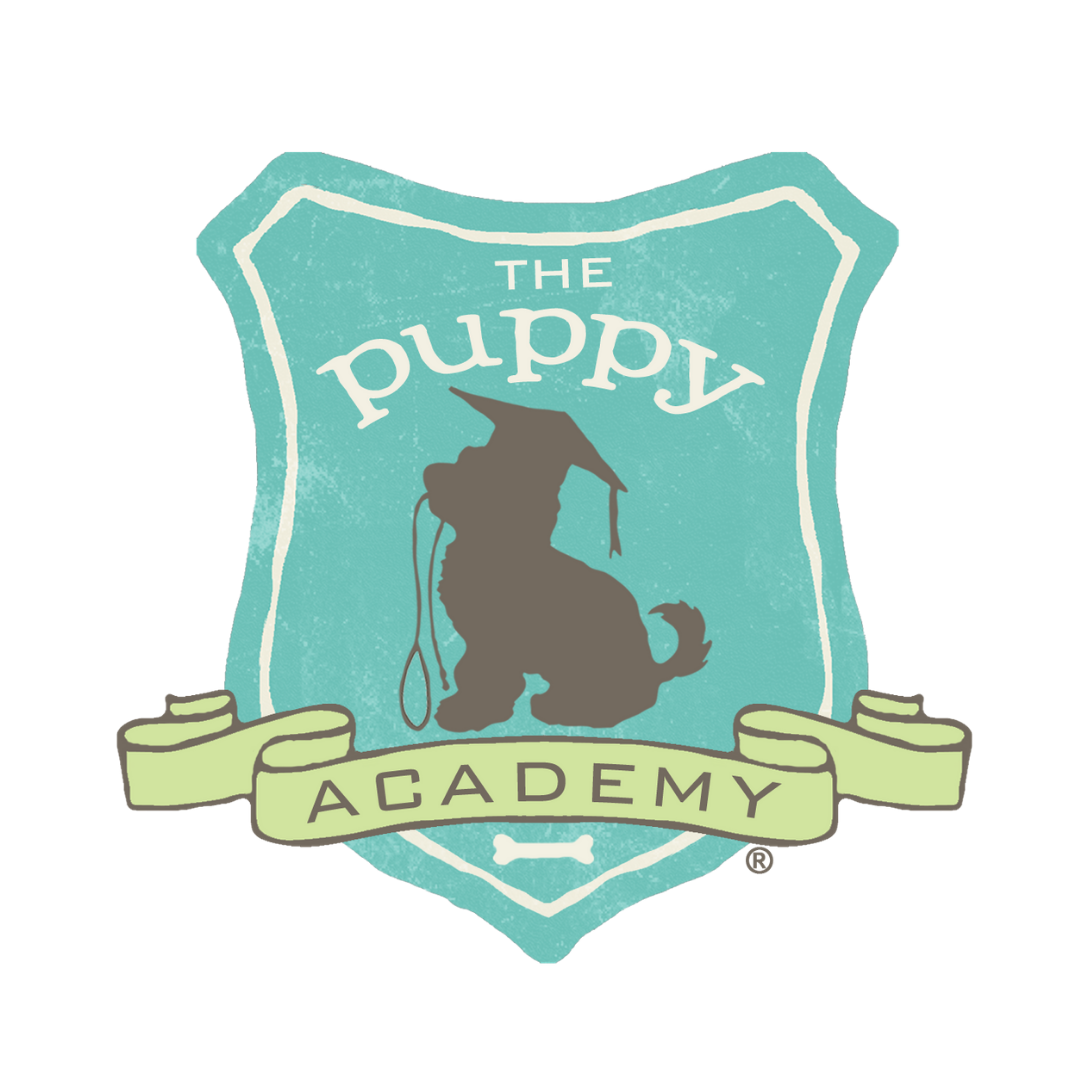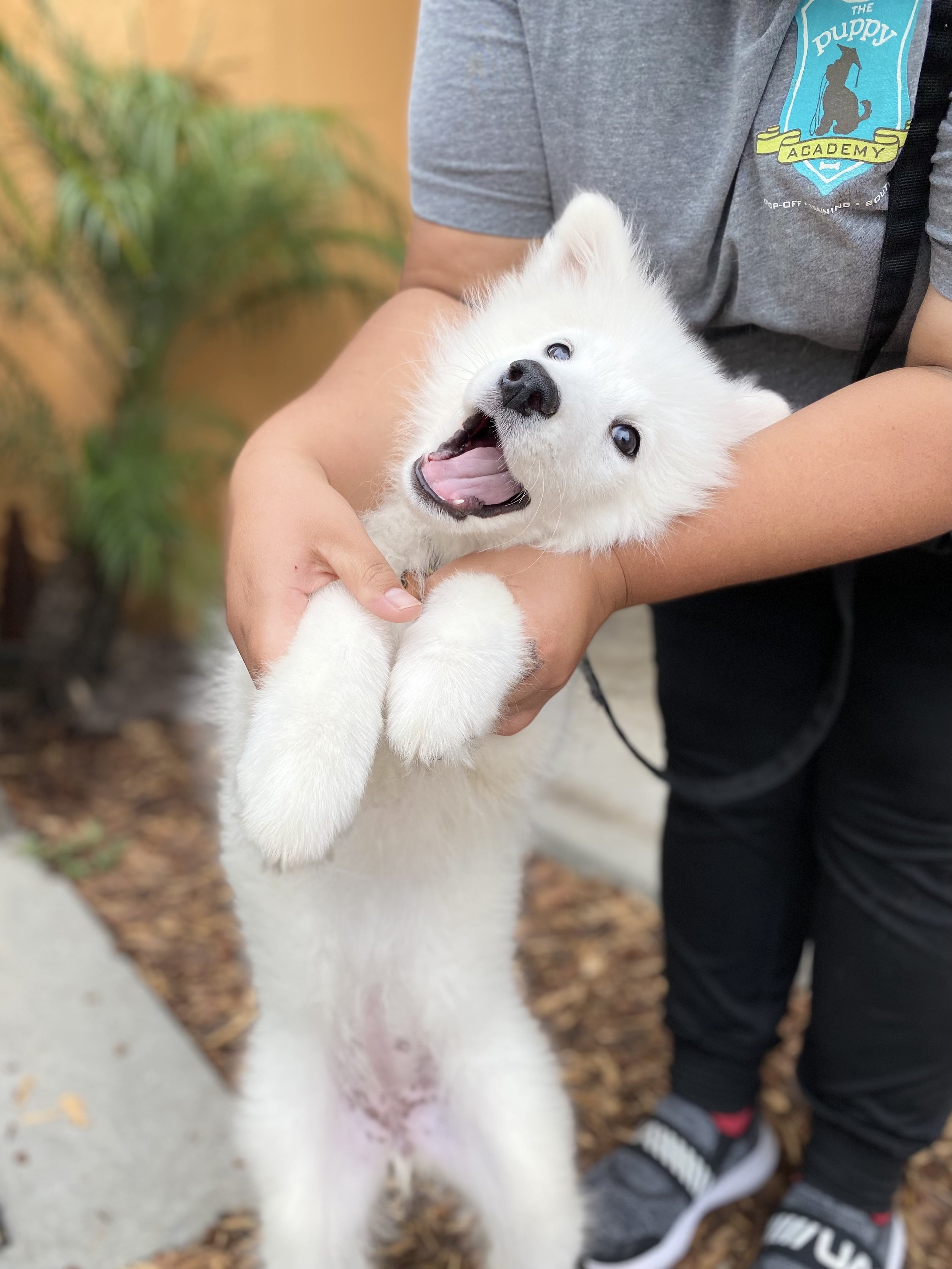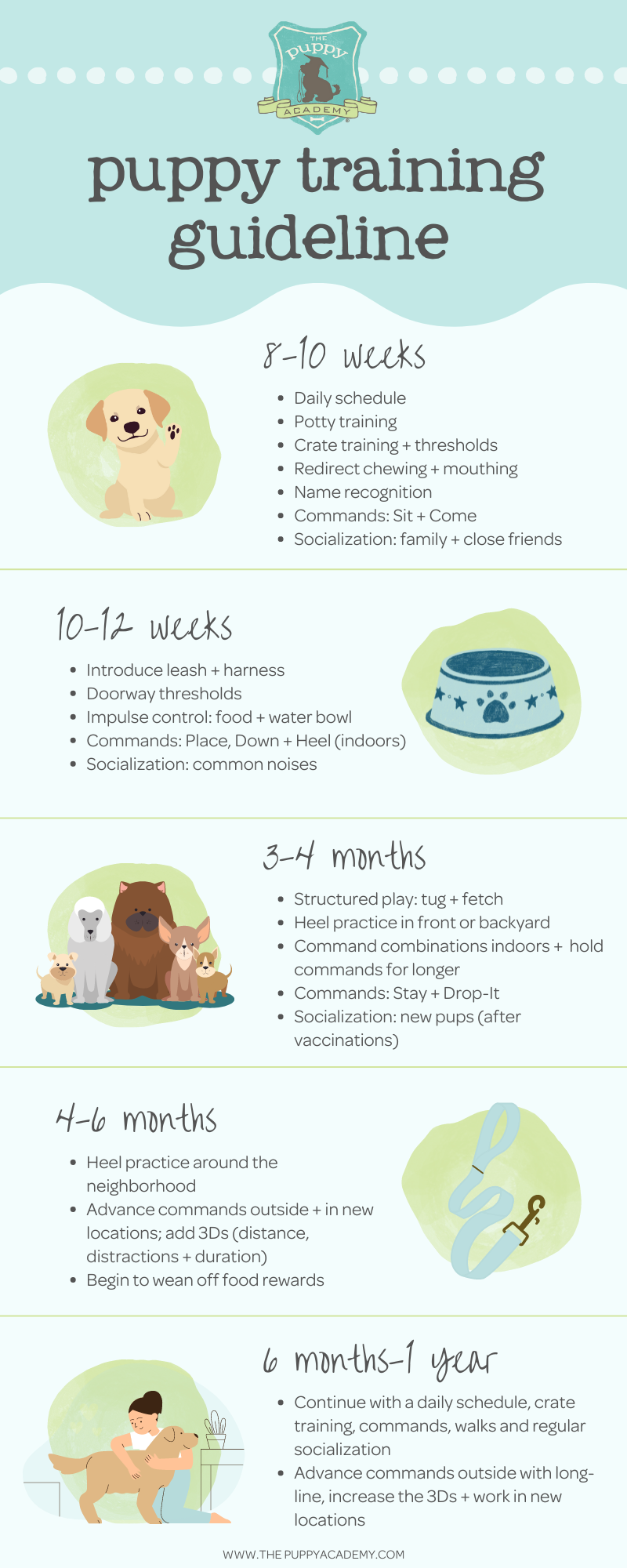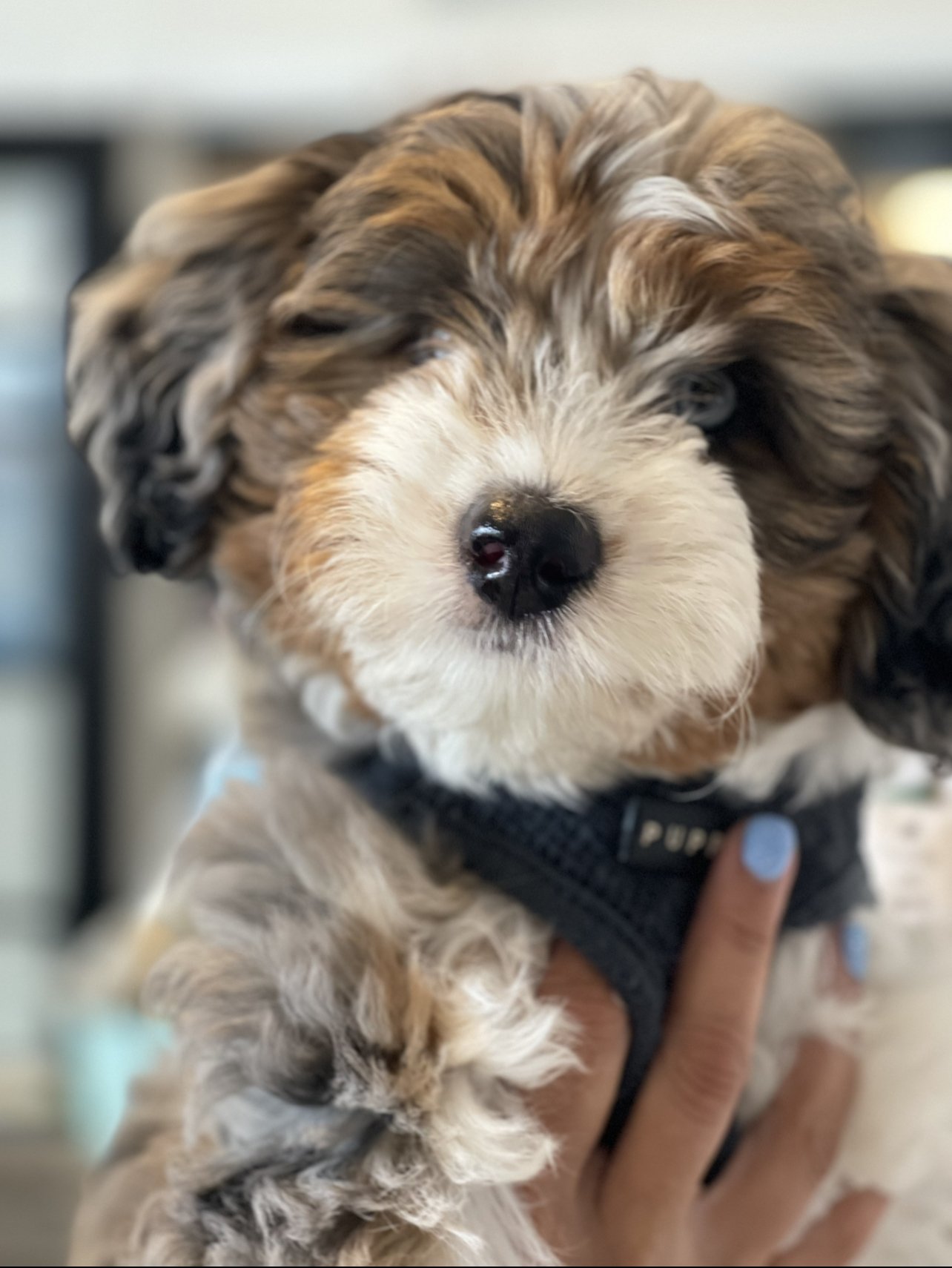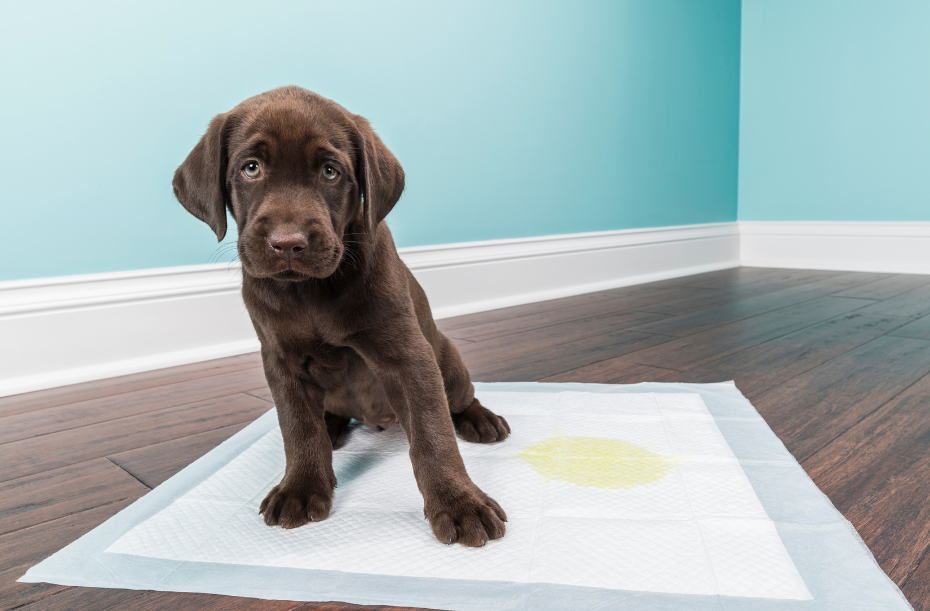Bringing home a new puppy is such an exciting time! But it can quickly become overwhelming when you start to wonder about what you should be teaching your puppy, when to do it, how to do it, and in what order to do it! In this blog we’re sharing our complete puppy training schedule you can follow to make puppyhood easy and get your pup off to the best (and most well-behaved!) start.
The perfect puppy...
It's the vision that we as puppy parents all dreamt about. A puppy that’s leisurely strolling beside you, or laying calmly at your feet at an outdoor cafe. But there are certain steps to do to make sure your pup is on the right track with their training in order to get there!
In the beginning, that perfect pup will come with some growing pains: nipping, chewing, potty accidents, barking, and that’s only the beginning! Your puppy is growing and developing quickly. Once they’ve been home for a couple of weeks, your puppy should becoming familiar with a daily routine and be working on some obedience training, which includes learning basic commands.
So how do you know what you should begin training your pup on first? No matter what age you bring home your new pup, you can use our puppy training schedule as a guideline to help your puppy grow, develop, and learn the good manners they need at home and in the world to help shape them into becoming that perfect pup you envisioned!
Let’s dive in with the three important things to remember and use to your advantage with training your new puppy:
1.Use your pup’s food for training!
Your puppy’s food is a phenomenal resource and one of the best tools you can use to train your puppy! In those early puppyhood months, having your puppy work for their food is a super easy way to get and hold their attention on you, rewards them for doing so, and creates a positive association with looking to you for direction!
At The Puppy Academy, we have our students bring their own lunch to school with the food they eat at home, and we use that meal for their training sessions. It’s also part of the foundation for our Online Training School. In both programs, you’ll often hear us recommending our pup parents keep a treat pouch on or near them at all times in the beginning weeks with their new pup at home. (Don’t worry, you can and will wean off as they get older!) Having access to your pup’s food comes in so handy for redirecting them away from something they’re doing that you don’t want them to do, getting them to come to you, having them focus on you to build that guidance-based relationship, and reward them for their good behaviors to encourage them to do it again!
2. Be Patient and Consistent!
It’s easy to become frustrated with the puppy training process. Puppies are young and still figuring out the world, so they will make mistakes, get distracted, and lose focus easily. It takes time to establish communication between yourself and your puppy, so don’t expect them to get it on the first try!
To get them on track faster, maintain a consistent schedule for your puppy. We recommend all our students use a daily puppy schedule that includes potty breaks, feeding and playtimes, puppy training sessions, and nap times! This will help your puppy learn to understand the daily household routine, feel confident and secure, provide structure, and promote good behavior.
3. Practice, Practice, Practice!
That saying “practice makes perfect” is totally true when it comes to puppy training! You’ll want to schedule a few short training sessions each day to teach and practice their commands. With young puppies, you may only be able to hold their attention for 5-10 minutes at a time, and about 10-15 minutes with older puppies. A great time to train is at your puppy's mealtime, as you have them work to earn their breakfast, lunch, or dinner!
Keep these training sessions short, fun, and motivating for your pup so they can't wait to do them again and again! Once your puppy has received their vaccinations, start practicing their training routines in different outdoor locations. This will help solidify their commands, and encourage the same good behaviors wherever you bring your puppy!
Now that we covered these three key topics, it's time to start your puppy’s training schedule! We’ve created a basic puppy training schedule that starts from two months (8 weeks) of age that you can use as your puppy grows through their first year! If your puppy is older and hasn’t learned everything outlined here yet, go back to fill in some of those missing areas if needed.
It's important to keep in mind that each pup learns at a different speed, so some may need longer at certain stages, while others will be able to move on to more advanced training quicker. Go at your pup's speed, and don't rush them if they're not quite ready yet to move onto the next just yet!
Save the puppy training schedule guideline here:
Puppy Training Schedule By Age Guideline
8-10 Weeks Old
This is around the age that many new puppy owners bring home their new puppy. During this phase of your pup’s life, they should be learning the basics such as their name, good manners at home, introducing some commands, and some early socialization.
Get your puppy used to a daily schedule that includes their feeding and water times, play and training times, potty breaks, and naptimes. Get our sample puppy schedule here, or learn how to create one that’s tailored to your puppy in our Online Puppy School!
Potty training your puppy should start as soon as your puppy comes home! The best way to start potty training your pup is by incorporating a potty schedule to teach your pup where to go on the right spot, and how to hold it! If you are trying to determine your potty training schedule, as a general guideline, take your puppy’s age in months and then divide it in half to determine how long they can go in between potty breaks. For more information on potty training your puppy, visit our potty training blog!
Crate training is one of the most valuable assets for puppy training and puppy parents! We find that it is super helpful at speeding up the housebreaking process and how it helps create an independent puppy and reduces separation anxiety. For more information on crate training your puppy, check out our crate training blog post! Plus, begin crate threshold training by having your puppy pause calmly before barging out as soon as the crate door opens. This will immediately start introducing them to learning impulse control, teaching boundaries, and helping set the expectations for other door thresholds as they get older.
Introduce basic obedience commands Sit & Come at this stage. These will be two of the most useful commands in your arsenal that you will probably use every day for the rest of your pup’s life. We recommend that you introduce these commands during mealtime. Start with some of your puppy’s food in your hand, let them smell it, and start taking backward steps away from them as you say “Come” with your hand extended out to lure them towards you. When they come to you, reward them with a “Good!” and the food! Next, you can teach them how to sit by arching your hand, with their food in it, up over their nose and past the top of their head as you say “Sit”, and when their butt hits the ground, again say “Good!” and give them the food again! Say the word “Come” when your puppy is following you for their food and water bowls This simple exercise of "Come" and "Sit" using the food lure is one of our favorite routines and a fantastic relationship-builder exercise to practice daily!".
For help teaching your puppy these commands, visit our blogs “Puppy Training 101: Giving Your Puppy Commands, the Right Way!” and “Puppy Training 101: How to Get Your Puppy Responding to Come!”
Start socialization with your family and close friends first. Throughout your pup’s life they will encounter new people so getting them used to it early on will help them positively associate those interactions.
Name recognition is super important and will be the one thing you’ll certainly use for the rest of your pup’s life! When interacting with your pup, say their name throughout the day and get their attention on you while saying their name. We love using food with this! Each time they look at you or come to you, reward them with excitement and the food! To help encourage eye contact, bring a piece of their food up to your eyes, and reward them when they look at you! Want a fun way to teach your puppy their name? Play the name game!
Start to redirect chewing and mouthing behaviors as they occur with the help of a chew toy! Your puppy will be exploring their world with their nose and mouth. You’ll want to make sure that they know the difference between your hands, feet, and shoes from their chew toys! Visit our puppy chewing and puppy nipping blogs for help!
For more help with potty training, nipping and getting your puppy to Come to you, watch our free masterclass:
10-12 Weeks Old
At this point, you will begin to expand on your pup’s commands, socialization, and impulse control.
Introduce more basic obedience commands such as Place, Down, and Heel inside the home, still using food rewards.
Introduce the leash and harness to your puppy if you have not already done so at 8-10 weeks. These will be the two most utilized tools in your pup’s life when they are out and about with you. Let your puppy get used to their harness and leash by letting them wear it around the house while you supervise them. For help with getting your puppy to love their leash and harness, visit our leash training blog!
Continue socialization by introducing new people and letting your puppy meet calm dogs post-vaccinations. A safe way to do this is having your pup in a playpen by the other pup, so they can observe and interact with a barrier in place. Additionally, start getting them used to common noises they will hear in everyday situations such as construction, traffic, garbage trucks, etc. by playing recordings that you can find in YouTube videos.
For more help socializing your puppy, visit our blog “Puppyhood Made Easy for New Owners: Socializing Your Puppy to Dogs & People!”
Impulse control practice by having your puppy wait for their food and water bowls. Ask them to Sit before setting down their bowls. Place their bowls down once they are calm and release them from sitting with a word like “Break” or “Okay”!
Start threshold training which involves asking your puppy to Sit at doorways, open doors, crosswalks, etc., and then walking through them calmly. This will help discourage your puppy from lunging and pulling each time they see an open doorway to another room, aka, a new adventure to explore, and helps your walks be calmer.
For more help teaching our puppy calm thresholds, visit our blog “Puppyhood Made Easy for New Owners: Teach Your Puppy Not to Bolt Out of Doorways!”
3-4 Months Old
Your puppy is starting to grow up quickly and you can start to work in more complex training routines with the commands they’ve learned!
Introduce Stay and Leave-It commands to your puppy!
Start command combinations and working indoors. Try to get your puppy practice duration work by holding their commands longer, for example, a long Sit and Stay, and also try to link some commands together! Here’s a fun combination to try: Sit > Down > Stay > Come > Place. You can work on different combinations to really keep your puppy engaged!
Practice Heel outdoors in your driveway or sidewalk in front of your house to ease them into some of the outside distractions! You may need a higher-value treat if their normal food isn't working to maintain their focus better!
Begin to socialize with other new pups after your puppy has received all their vaccinations! Remember it's not the quantity of interactions, but the quality of them which is key! Make sure you are matching your pup's personality with others that suite them. Don't force your pup to interact with pups or people they don't want to, and don't let pups "work it out" among themselves. Monitor your pup's play and step in to interrupt it when needed, while they're learning.
Introduce structured play sessions, if you haven't yet, of fetch and tug, which will also help improve their Drop-it, Come and Stay commands!
4-6 Months Old
At this point, your puppy should start to work on their commands outside your home and in public spaces, as well as continue to socialize!
Advance on their commands by practicing them outside your home in the front or backyard. Bring your puppy to a new location, such as the park, and practice their commands and some command combinations. As your pup gets better, start adding in the 3Ds: distance, duration and distractions to their command work!
Extend your walks with your puppy from down the block to further down the block. Work on your puppy’s leash training and Heel command!
Start to wean your puppy off of food rewards at this point while they are training by asking for several commands first before giving a food reward, or by using praise or affection when they respond with the correct behavior instead!
6 Months - 1 Year Old
Your puppy should know all of their basic commands and have a solid foundation of potty training, crate training, and socialization. From this point on, you will continue to work with your puppy to reinforce what they have already learned!
Continue to reinforce all the commands your puppy has learned and start to increase the 3Ds! Introduce more distance between you and your pup as you practice their commands, have them hold commands for longer periods of time, and had in more distractions to have them work through! We recommend using a long-line to practice these safely outdoors and don't forget to include Recall to practice your pup coming to you from longer distances. Challenge your pup by bringing them to more populated areas with different distractions for them to work through and improve their skills!
Maintain structure at home! Your puppy is in an adolescent phase and can act up if left to their own devices. It’s not uncommon for pups to start chewing, nipping, potty accidents, or other behaviors if their training and structure start to ease up at home! It's not uncommon to see regression in your pup's training temporarily during this time. Stick to your schedule and daily training sessions to help get your pup get over this hump faster!
If this sounds like A LOT — we get it — IT IS!! But we also know how to make it super simple for you. Follow our full puppy training blueprint and learn all the routines we’ve mentioned above, while working right alongside our expert puppy trainers with The Puppy Academy Online School! Created for busy new puppy parents, we’ve eliminated all the guess work, given you an easy step-by-step template to follow AND you have access to our professional trainers to get all your puppy questions answered for an entire year! We’ve got your back and we’ll make puppyhood easy for you. :) Enroll here and get started today! Or read the full review here!
Or if you live in the Los Angeles area, your puppy can attend our day school for us to put this puppy schedule into full action for you. Set up your free consultation here!
Final Training Schedule Notes: Generally, every week and month should progress with socialization: meeting new people, other puppies, experiences, noises, etc. You should continue progressing their potty schedule and eventually as your puppy grows and can hold it longer, start increasing the time between potty breaks.
The first whole year of your puppy’s life will involve basic obedience training, reinforcing good manners in the home, and maintaining structure. Doing this consistently, you can ensure that your puppy will retain their training and good behaviors throughout the rest of their life. Even if your puppy started at an older age, you can work on catching your puppy up so they are on track to being well-behaved by the time they reach their 1-year mark!
Have more questions about a puppy training schedule for your puppy? Ask our trainers LIVE every Wednesday at 1 pm PT on our Instagram @thepuppyacademy during our Ask A Puppy Trainer Show! All replays are posted afterward, and you can catch up on our last ones on our YouTube channel!
Become a Puppy Academy VIP (Very Important Puppy) to get our latest puppy training tips direct to your inbox, for free, each week!
Looking for the perfect present for the new puppy parent in your life? (Yes, that’s YOU too!) Document all those special puppyhood moments with our official Puppy Memory Book!:
Check out these blogs related to puppy training and more!
How to Teach Your Puppy to Walk on a Leash!
How to Teach Your Puppy Good Manners!
Debunking Common Puppy Training Myths!
